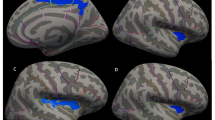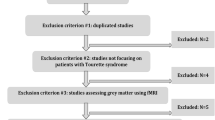Abstract
Fraternal twin studies on normal subjects have demonstrated low heritability (intra-class correlation coefficient) estimates for frontal brain regions (r = 0.43). Here we aimed to investigate the relatedness/similarity estimates of the frontal brain regions in fraternal subjects concordant for Tourette syndrome (TS). We sought to identify regional brain similarities between siblings concordant for TS as an exploratory step towards the identification of potential brain structures involved in the TS phenotype. The identified brain structures may then serve in subsequent molecular genetic and linkage studies. In addition, we regressed cortical thickness and TS clinical severity scores to assess the relation between TS clinical symptoms and cortical structures. Sixteen sibling pairs concordant for TS were scanned using a 1.5 T magnetic resonance imaging scanner (age range 10–25, mean 17.19 ± 4.1). Brain morphology was assessed using the fully automated Civet pipeline at the Montreal Neurological Institute. TS was assessed using the Children’s Yale-Brown Obsessive Compulsive Scale (CY-BOCS), Yale Global Tic Severity Scale (YGTSS) and the Goetz Tic Scale. We report high relatedness/similarity estimates for fraternal siblings concordant for TS (r = 0.86–0.60) in the middle frontal-motor/cingulate/insular cortices. Regression analysis revealed significant negative correlations in the right insula with the YGTSS (r = −0.41, F = 6.09, P < 0.02) and the left cingulated cortex with the (CY-BOCS) (r = −0.35, F = 4.30, P < 0.05). Since previous findings have concluded that normal fraternal siblings are less alike in frontal cortices, the present findings may be attributed to TS. We speculate that the high ICC between siblings and the negative correlation between TS symptoms severity and cortical thickness measurements are related to the disturbances in the maturation of the motor–cingulate–insular cortical neural system that mediate self-regulatory processes. Such delayed maturation may consequently contribute to the development of TS by releasing motor and vocal tics from regulatory control. These findings may have important genetic implications.


Similar content being viewed by others
References
American Psychiatric Association (1994) Diagnostic and statistical manual of mental disorders, 4th edn. American Psychiatric Association, Washington, DC
Aruga J, Yokota N, Mikoshiba K (2003) Human SLITRK family genes: genomic organization and expression profiling in normal brain and brain tumor tissue. Gene 315(2):87–94
Bohlhalter S, Goldfine A, Matteson S, Garraux G, Hanakawa T, Kansaku K, Wurzman R, Hallett M (2006) Neural correlates of tic generation in Tourette syndrome: an event-related functional MRI study. Brain 129(Pt 8):2029–2037
Chung MK, Worsley KJ, Robbins S, Paus T, Taylor J, Giedd JN, Rapoport JL, Evans AC (2003) Deformation-based surface morphometry applied to gray matter deformation. Neuroimage 18(2):198–213
Devinsky O, Morrell MJ, Vogt BA (1995) Contributions of anterior cingulate cortex to behaviour. Brain 118:279–306
Giedd JN, Schmitt JE, Neale MC (2007) Structural brain magnetic resonance imaging of pediatric twins. Hum Brain Mapp 28(6):474–481
Goetz CG, Tanner CM, Wilson RS, Shannon KM (1987) A rating scale for Gilles de la Tourette’s syndrome: description, reliability, and validity data. Neurology 7:1542–1544
Hilgetag CC, Barbas H (2005) Developmental mechanics of the primate cerebral cortex. Anat Embryol (Berl) 210(5-6):411–417
Kawohl W, Bruhl A, Krowatschek G, Ketteler D, Herwig U (2008) Functional magnetic resonance imaging of tics and tic suppression in Gilles de la Tourette syndrome. World J Biol Psychiatry 3:1–4. Retrieved August 27, 2009 from http://www.informaworld.com/10.1080/15622970802118356
Laurin N, Wigg KG, Feng Y, Sandor P, Barr CL (2009) Chromosome 5 and Gilles de la Tourette syndrome: linkage in a large pedigree and association study of six candidates in the region. Am J Med Genet B Neuropsychiatr Genet 150B(1):95–103
Leckman JF, Riddle MA, Hardin MT, Ort SI, Swartz KL, Stevenson J, Cohen DJ (1989) The Yale Global Tic severity scale: initial testing of a clinician-rated scale of tic-severity. J Am Acad Child Adolesc Psychiatry 28:566–573
Leckman JF, Knorr AM, Rasmusson AM, Cohen DJ (1991) Basal ganglia research and Tourette’s syndrome. Trends Neurosci 14:94
Leckman JF, Zhang H, Vitale Lahnin F, Lynch K, Bondi C, Kim YS, Peterson BS (1998) Course of tic severity in Tourette’s syndrome: the first two decades. Pediatrics 102:14–19
Leckman JF, Cohen DJ, Goetz CG, Jankovic J (2001) Tourette syndrome: pieces of the puzzle. Adv Neurol 85:369–390
Lenroot RK, Schmitt JE, Ordaz SJ, Wallace GL, Neale MC, Lerch JP, Kendler KS, Evans AC, Giedd JN (2009) Differences in genetic and environmental influences on the human cerebral cortex associated with development during childhood and adolescence. Hum Brain Mapp 30(1):163–174
Lerch JP, Evans AC (2005) Cortical thickness analysis examined through power analysis and a population simulation. Neuroimage 24:163–173
Lyttelton O, Boucher M, Robbins S, Evans A (2007) An unbiased iterative group registration template for cortical surface analysis. Neuroimage 34:1535–1544
Marsh R, Zhu H, Wang Z, Skudlarski P, Peterson BS (2007) A developmental fMRI study of self-regulatory control in Tourette’s syndrome. Am J Psychiatry 164(6):955–966
Miodonski A (1974) The angioarchitectonics and cytoarchitectonics (impregnation modo Golgi-Cox) structure of the fissural frontal neocortex in dog. Folia Biol (Krakow) 22:237–279
Oldfield RC (1971) The assessment and analysis of handedness: the Edinburgh inventory. Neuropsychologia 9:97–113
Pauls DL (2003) An update on the genetics of Gilles de la Tourette syndrome. J Psychosom Res 55(1):7–12
Peper JS, Schnack HG, Brouwer RM, Van Baal GC, Pjetri E, Székely E, van Leeuwen M, van den Berg SM, Collins DL, Evans AC, Boomsma DI, Kahn RS, Hulshoff Pol HE (2009). Heritability of regional and global brain structure at the onset of puberty: a magnetic resonance imaging study in 9-year-old twin pairs. Hum Brain Mapp 30(7):2184–2196
Plomin R, Kosslyn SM (2001) Genes, brain and cognition. Nat Neurosci 4(12):1253–1258
Rakic P (1995) A small step for the cell, a giant leap for mankind: a hypothesis of neocortical expansion during evolution. Trends Neurosci 18:383–388
Robbins S, Evans AC, Collins DL, Whitesides S (2004) Tuning and comparing spatial normalization methods. Med Image Anal 8(3):311–323
Robertson MM (1989) The Gilles de la Tourette syndrome: the current status. Br J Psychiatry 154:147–169
Robertson MM, Cavanna AE (2007) The disaster was my fault! Neurocase 13(5):446–451
Robertson MM, Eapen V (1992) Pharmacologic controversy of CNS stimulants in Gilles de la Tourette’s syndrome. Clin Neuropharmacol 15(5):408–425
Scahill L, Riddle MA, McSwiggin-Hardin M, Ort SI, King RA, Goodman WK, Cicchetti D, Leckman JF (1997) Children’s Yale-Brown Obsessive Compulsive Scale: reliability and validity. J Am Acad Child Adolesc Psychiatry 36:844–852
Sled JG, Zijdenbos AP, Evans AC (1998) A nonparametric method for automatic correction of intensity nonuniformity in MRI data. IEEE Trans Med Imaging 17:87–97
Speed WC, O’Roak BJ, Tárnok Z, Barta C, Pakstis AJ, State MW, Kidd KK (2008) Haplotype evolution of SLITRK1, a candidate gene for Gilles de la Tourette syndrome. Am J Med Genet B Neuropsychiatr Genet 147B(4):463–466
The Tourette Syndrome Association International Consortium for Genetics (2007) Genome scan for Tourette disorder in affected-sibling-pair and multigenerational families. Am J Hum Genet 80:265–272
Thompson PM, Cannon TD, Narr KL, van Erp T, Poutanen VP, Huttunen M, Lönnqvist J, Standertskjöld-Nordenstam CG, Kaprio J, Khaledy M, Dail R, Zoumalan CI, Toga AW (2001) Genetic influences on brain structure. Nat Neurosci 4(12):1253–1258
Verkerk AJ, Cath DC, van der Linde HC, Both J, Heutink P, Breedveld G, Aulchenko YS, Oostra BA (2006) Genetic and clinical analysis of a large Dutch Gilles de la Tourette family. Mol Psychiatry 11(10):954–964
Wallace GL, Eric Schmitt J, Lenroot R, Viding E, Ordaz S, Rosenthal MA, Molloy EA, Clasen LS, Kendler KS, Neale MC, Giedd JN (2006) A pediatric twin study of brain morphometry. J Child Psychol Psychiatry 47(10):987–993
Yoon U, Fahim C, Perusse D, Evans A (2008). Genetic analysis of cortical thickness in 8-year-old twins. In: The 14th international conference on funtional mapping of the human brain, Melbourne, Australia. NeuroImage, vol 41, p S55
Zijdenbos AP, Forghani R, Evans AC (2002) Automatic pipeline analysis of 3-D MRI data for clinical trials: application to multiple sclerosis. IEEE Trans Med Imaging 21:1280–1291
Acknowledgments
We thank the subjects who participated in this study. C·F. is a post-doctoral fellow of the Canadian Institutes of Health Research (CIHR), of the CIHR Genes, Mind, Behavior Training Program (M. Meany, PI) and the Jeanne Timmins Costello at the Montreal Neurological Institute.
Author information
Authors and Affiliations
Corresponding author
Rights and permissions
About this article
Cite this article
Fahim, C., Yoon, U., Sandor, P. et al. Thinning of the Motor–Cingulate–Insular Cortices in Siblings Concordant for Tourette Syndrome. Brain Topogr 22, 176–184 (2009). https://doi.org/10.1007/s10548-009-0105-6
Received:
Accepted:
Published:
Issue Date:
DOI: https://doi.org/10.1007/s10548-009-0105-6




